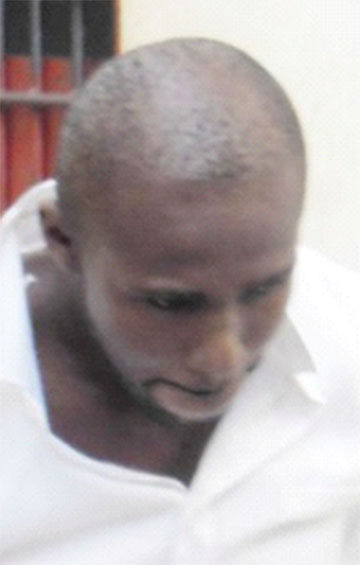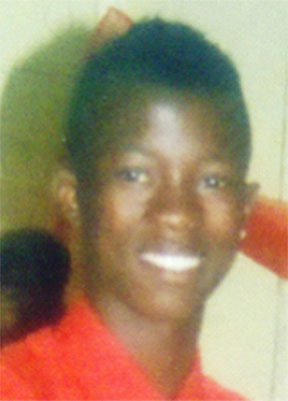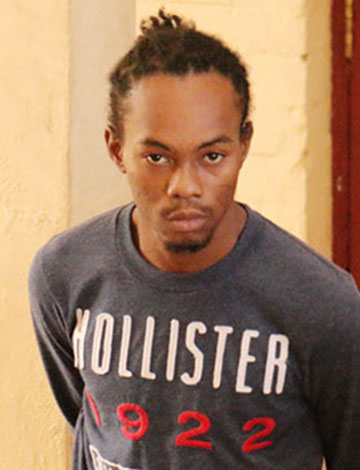Convict Romel Bollers, who was present when Shaquille Grant was fatally shot during an encounter with police at Agricola, yesterday refuted evidence suggesting that he had opened fire on lawmen, prompting them to shoot back.
A shackled Bollers, who took the witness stand at the High Court under police guard, testified that contrary to what police have claimed, neither he nor any of his friends were armed when police opened fire on them on September 11, 2012.
Bollers was at the time testifying at the trial of former police constable Terrence Wallace, who is accused of murdering Grant, 17, at Caesar Street, Agricola, East Bank Demerara on September 11, 2012.
He has denied the charge.
When asked by Prosecutor Judith Gildharie-Mursalin how he had come to be incarcerated, Bollers appeared to be immediately riled by the question. “I end-up in this due to victimisation concerning this same matter,” he said.
He noted that he has been in prison for four months and one day of a one-year sentence that was imposed after he was convicted for stealing.
“They claim that I thief some motorbike and how I involve in some shooting but I know nothing of such. All ah this is share police victimisation,” he claimed.
Recalling September 11, 2012, Bollers said that he, along with his friends Grant, Troy Greenidge, Timothy Eastman and Jamal Henry called ‘Tuna,’ were conversing under a shed at Lot 110 Caesar Street, when he heard a voice say, “No body don’t run.”
Bollers said he was backing the speaker but looked over his shoulder and recognised a police officer, whose name he later learnt to be “Wallace,” the accused.
He said Wallace then ordered everyone to “go down on the ground.” As he was following the instruction, he said he asked the officer if he could be allowed to take his cellphone from the waist of his pants. He said Wallace did not answer his request.
Asked why he first wanted to remove his phone, Bollers told Gildharie-Mursalin that it was an expensive iPhone 4S, which he had worked hard in the interior to purchase, and he not want the device to get damaged.
Although Wallace did not respond to his request, Bollers said that he nevertheless proceeded to quickly remove the phone, before lying flat on the ground. He said at this point Wallace dealt him a blow to the left-side of his face with his gun.
He said afterward Wallace immediately shot him behind the head. The witness pointed to behind both ears, where he said the bullet entered and exited.
‘I get shoot’
He said after being shot, he fell flat on the ground along with Grant, Greenidge, Henry and Eastman. He said after he was shot, he immediately heard Grant saying, “Ah, ah officer, I get shoot.”
Bollers said he then heard the voice of an “Indian” man saying, “duh man ain’t dead yet,” at which point he said he heard two more shots go off. He said he did not see who had fired those additional shots but added that by then he saw a number of other policemen.
Bollers’ identification of an “Indian” voice prompted trial judge Navindra Singh to ask him how he knew that it was an Indian person who was speaking. The witness then responded, “Well, yuh know Indian country voice; yuh would know it when yuh hear it.”
Bollers was asked how Grant appeared to him at that time. “He look like he done die to me,” he said, adding, “He had a bullet in he forehead.”
He said after the shooting, Wallace insisted that he remain flat on the ground, even though he explained to him that he felt faint and unwell. Bollers said it was another officer, Warren Blue, who allowed him to brace his back against a wall.
The witness said after Grant, with whom he grew up, was thrown by lawmen into the back of a police vehicle, a crowd of people gathered and a scuffle ensued between them and the police.
He said on September 17, 2012, he, in the company of attorneys Nigel Hughes and James Bond, activist Mark Benschop, Grant’s mother and relatives, went to Eve Leary, where, in tears, he identified Wallace as the man who shot him.
In a heated exchange with Wallace’s attorney, Sonia Parag, Bollers maintained that he never fired at police.
Bollers disagreed with a suggestion from the attorney that on the day in question he was armed with a .38 Smith and Wesson revolver.
“Only if you give me,” he told her.
“You will see it when it comes,” counsel responded.
He also disagreed with counsel that it was he who attacked and first fired at the police, causing lawmen to return fire. During the cross-examination, Bollers shook his head in the negative and described Parag as being “real complicated.”
He also answered in the negative when asked if he had seen the officer who shot at Grant.
Counsel suggested to Bollers that in his statement, he never said that the accused had shot him. The witness disagreed. Stating that he cannot read “too good,” he said he was certain that he told the police that the accused had shot him, but surmised that they probably failed to record it in the statement which he gave.
Parag also asked him whether, after being taken to the Brickdam Police Station where he said he spent 72 hours in the lockups, he had complained to other ranks about Wallace hitting him with his firearm.
“All ah dem is police when done,” was his initial response, though he eventually answered “no.”
Defence counsel then asked Bollers whether it was not true that before his current sentence, he was convicted and sentenced to three years imprisonment on a robbery charge.
“All ah duh is victimisation. They claim I rob some girl, but I know nothing about that. Is victimisation all the way,” Bollers advanced.
He calmly admitted that it was true that he was convicted for three years on a robbery charge, but said the Magistrate who sentenced him “see me just suh and sentence me.” He added that he had appealed that sentence.
Defending himself
Meanwhile, also testifying at yesterday’s hearing was Inspector Philip Bowman, who said he visited the scene and assisted in the investigation. He also recalled putting the allegation to Wallace that he murdered Grant, to which he responded, “I am innocent.” He said he also witnessed him write two ordinary statements.
Bowman read the statements to the court in which Wallace said that he and other ranks went to the Agricola location after receiving information that Bollers and his friends were planning a robbery.
The statements said that after the lawmen arrived, Bollers reached for a gun from his waist and opened fire on the ranks at the scene while attempting to run, after Wallace had shouted, “Freeze! Police!”
Wallace, in one of the statements, said that he in-turn discharged a round from his weapon and just then he heard two other shots. He said the sounds came from behind him but he could not say which ranks had fired.
The statement said Bollers then dropped the gun, which was revealed to be a .38 Smith and Wesson revolver.
Under cross-examination, Bowman agreed that from what he read in the statement, it seemed that the accused was under attack, prompting him to open fire.
He also agreed that it is lawful for police to return fire if met with gunfire once there is no other means by which they can protect or defend themselves.
He again agreed with Parag that based on the statement Wallace wrote, and which he read, the accused was defending himself.
Testifying also was Constable Ivan Roopnarine, who was one of the ranks at the scene on the day in question. He testified to seeing Bollers remove a gun from his waist and opening fire in the direction of the police.
Assistant Superintendent Alwyn Wilson and Lance Corporal Troy Canterbury also took the stand.
Wilson agreed with both defence counsel and the Judge, when asked, that to have had the accused placed by himself in uniform to be pointed out by Bollers was an unfair way of conducting an ID parade.
Wilson had testified about Bollers identifying Wallace as the person who had shot him.
Of the 21 witnesses to be called by the state, 11 have so far testified.
The trial continues this morning at 9.
Lance Corporal Blue and Special Constable Jamal Lewis were also charged with Grant’s murder, but were never arrested. Warrants had been issued for their arrest. While Lewis remains at large, Blue was subsequently shot and killed during a botched robbery on the East Coast Demerara.







